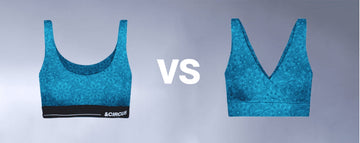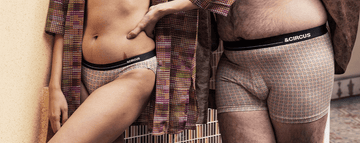The quest for the softest fabrics has become a quiet revolution in the innerwear industry. Picture slipping into a pair of micromodal briefs so smooth they feel like a second skin, or a maternity top that cradles without clinging. This isn't just about luxury it's about redefining how we experience clothing next to our skin. As consumers demand both unparalleled softness and eco-conscious production, the textile world is responding with innovations that are as gentle on the planet as they are on our bodies.
Uncomfortable underwear shouldn't steal your confidence. At Andcircus, we craft ultra-soft, sustainable Lenzing Modal Micro® innerwear for every body, XS to 5XL. From briefs to bras, our custom packs fit you perfectly. Shop risk-free with our 100% satisfaction guarantee and embrace comfort that includes everyone. #LoveEveryBody. Shop Now!
How Innovation is Shaping Innerwear Fabric Selection
The tactile allure of a garment its hand feel is no longer a vague, subjective quality. It's a measurable standard driving decisions in design studios and factories alike. Softness, once a secondary consideration, now rivals sustainability as a benchmark for premium innerwear, particularly in the burgeoning micromodal sector. From men's boxers to women's loungewear and maternity lines, brands are racing to perfect the balance of buttery texture and ethical sourcing. The result? A new era of clothing that feels as good as it looks and does good, too.
Micromodal, a cellulose-based fiber derived from beech trees, has emerged as the darling of this movement. Its silky texture and breathability make it a favorite for intimatewear, but what sets it apart is its eco-friendly edge. Unlike synthetic fibers, micromodal is biodegradable, aligning with the growing consumer demand for sustainable textiles. According to a 2024 report by Precedence Research, the global textile market, valued at $1,976.84 billion in 2024, is projected to reach $4,016.50 billion by 2034, driven in part by the rising popularity of natural fibers like micromodal. Asia Pacific, holding a 54% market share, leads the charge, with brands increasingly sourcing these fibers for their softness and green credentials.
The Science of Softness
The pursuit of softness isn't just about feel it's about science. Textile engineers are developing new ways to quantify hand feel, moving beyond subjective descriptors to standardized metrics. Tactile performance testing, for instance, measures smoothness, stiffness, and drape, offering a data-driven approach to what was once a matter of opinion. This shift is critical as brands compete to differentiate themselves in a crowded market. “Softness is no longer a buzzword; it's a specification,” says a textile engineer quoted in industry discussions, emphasizing how measurable standards are reshaping product development.
Innovations in fabric softeners are also playing a starring role. Research published on arXiv highlights the development of concentrated fabric softeners using esterquat surfactants, primarily derived from palm oil, which can be reduced by up to 50% and replaced with natural guar polymers without sacrificing performance. A follow-up study on arXiv explores advanced guar biopolymer-based conditioners, noting their ability to form colloidal dispersions that enhance softness while lowering environmental impact. These eco-friendly formulations, often biodegradable and non-toxic, are gaining traction as brands seek to meet consumer expectations for sustainability without compromising on that coveted silky touch.
Brands Leading the Charge
Enter brands like AndCircus, a rising star in the micromodal innerwear space. Their maternity collections, designed with expectant mothers in mind, prioritize softness to reduce irritation on sensitive skin. By leveraging micromodal's superior hand feel, AndCircus has carved out a niche in a market where comfort is non-negotiable. Other startups are following suit, experimenting with lab-engineered fiber blends that cater to gender-inclusive designs, ensuring everyone can experience the joy of a garment that feels like a whisper against the skin.
Retailers are also getting creative. Pop-up stores now emphasize “touch and feel” experiences, letting customers run their hands over fabrics before buying. Online, brands are experimenting with virtual simulations think 3D renderings that mimic the sensation of stroking micromodal. These innovations reflect a broader trend: softness is becoming a tangible selling point, not just a promise. As Allied Market Research notes, the global textile fabrics market, valued at $498 billion in 2021, is expected to reach $942.8 billion by 2031, fueled by demand for eco-friendly and functional fabrics. Softness, it seems, is a key driver of this growth.
The Challenges of Chasing Ultra-Softness
But the road to supreme softness isn't without bumps. Balancing tactile perfection with durability and elasticity is a persistent challenge. Ultra-soft fabrics can sometimes lack the resilience needed for daily wear, leading to pilling or stretching. Advanced softening processes, like those using guar-based conditioners, often come with higher production costs, which can price out smaller brands. Regulatory inconsistencies across markets further complicate matters, as softness standards vary widely, leaving room for misleading claims. Fast fashion giants, notorious for greenwashing, sometimes tout “soft” fabrics that rely on synthetic chemicals, undermining the eco-friendly ethos that micromodal champions.
Despite these hurdles, the rewards are substantial. Softer fabrics reduce chafing, a boon for sensitive skin and maternity wearers. They also enhance wearability, encouraging consumers to keep garments longer a win for sustainability. Brands that crack the softness code stand to gain a competitive edge, particularly in e-commerce, where a “softness index” label could become the next must-have feature. Imagine browsing an online store and seeing a numerical softness rating next to each product, backed by lab data. It's not far off, and it could redefine how we shop for clothes.
A Memorable The Softness Revolution
The future of innerwear is soft, sustainable, and smart. Textile engineers predict that AI and sensor technology will soon play a bigger role, analyzing consumer perceptions of softness in real time during the design process. Brands that embrace these advancements will not only meet but anticipate customer desires, creating garments that feel like a hug from the earth itself. For the micromodal sector, the message is clear: softness isn't just a feature it's the foundation of a new kind of luxury, one that prioritizes both comfort and conscience.
As you slip into your favorite pair of micromodal pajamas tonight, consider this: the fabric caressing your skin is the result of years of innovation, from biodegradable softeners to rigorous tactile testing. It's a reminder that in an industry often criticized for its environmental toll, softness is becoming a symbol of progress. The brands that thrive will be those that make us feel good inside and out.
Frequently Asked Questions
How do softness advances influence fabric selection in the fashion industry?
Advances in softness measurement and material science have enabled designers to select fabrics that balance comfort, durability, and aesthetic appeal. Improved standards help manufacturers tailor textiles to specific consumer preferences, particularly in sensitive categories like innerwear and loungewear.
What technologies are used to evaluate softness in modern textile production?
The blog highlights methods such as hand-feel tests, mechanical softness analyzers, and user surveys that assess how fabrics interact with skin. These tools support manufacturers in refining fabric blends to achieve optimal softness for different product lines.
Why is fabric softness important to consumers when purchasing apparel?
Softness significantly affects perceived comfort, especially in garments worn close to the skin. As consumers increasingly prioritize tactile comfort, brands that offer softer materials often gain a competitive edge in categories like underwear, sleepwear, and activewear.
Disclaimer: The above helpful resources content contains personal opinions and experiences. The information provided is for general knowledge and does not constitute professional advice.
You may also be interested in: Why Micromodal Fabrics Are Ideal for Sensitive Skin
Uncomfortable underwear shouldn't steal your confidence. At Andcircus, we craft ultra-soft, sustainable Lenzing Modal Micro® innerwear for every body, XS to 5XL. From briefs to bras, our custom packs fit you perfectly. Shop risk-free with our 100% satisfaction guarantee and embrace comfort that includes everyone. #LoveEveryBody. Shop Now!






































